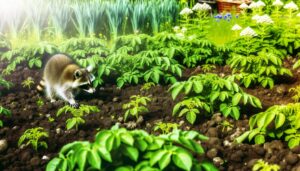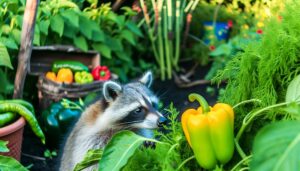How Do Raccoons Eat Moles and Voles?
Yes, raccoons do eat moles and voles as part of their omnivorous diet. These nocturnal mammals are opportunistic feeders, employing strategies that include using their keen sense of smell and dexterous forepaws to dig and capture these small mammals.
Moles and voles offer nutritional value and are readily available prey, aligning well with raccoons' adaptive foraging behaviors. This predation helps regulate small mammal populations, indirectly benefiting ecosystem health by preventing overgrazing and soil degradation.
Understanding raccoon feeding habits and behaviors can offer insights into their critical role in ecological dynamics.
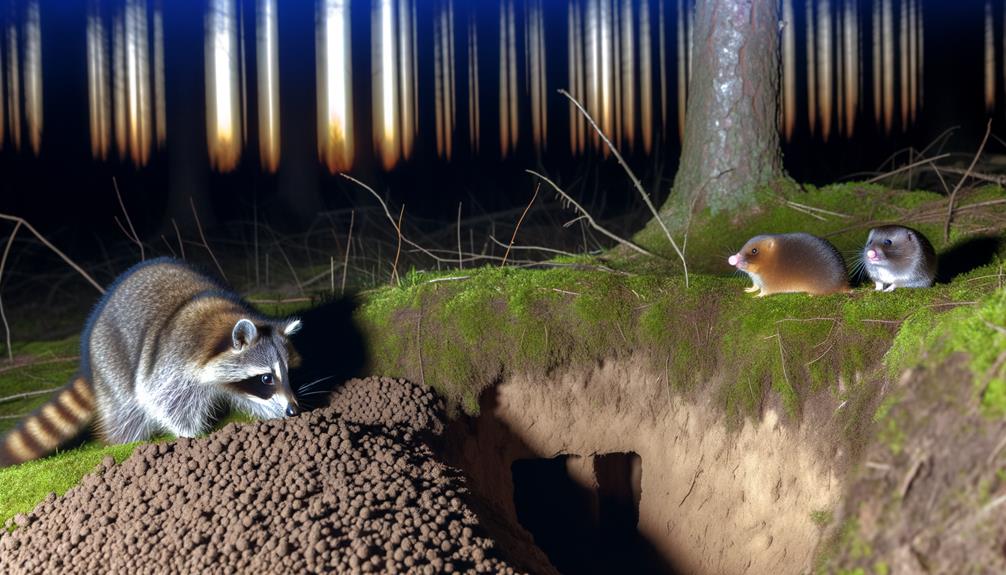
Key Takeaways
- Raccoons eat moles and voles as part of their omnivorous diet.
- Moles and voles provide a nutritious and readily available food source for raccoons.
- Raccoons use their keen sense of smell and dexterous forepaws to hunt moles and voles.
- Hunting moles and voles helps raccoons regulate small mammal populations and maintain ecosystem balance.
- Raccoons' adaptive foraging strategies make them effective predators of subterranean and small mammals like moles and voles.
Raccoons' General Diet
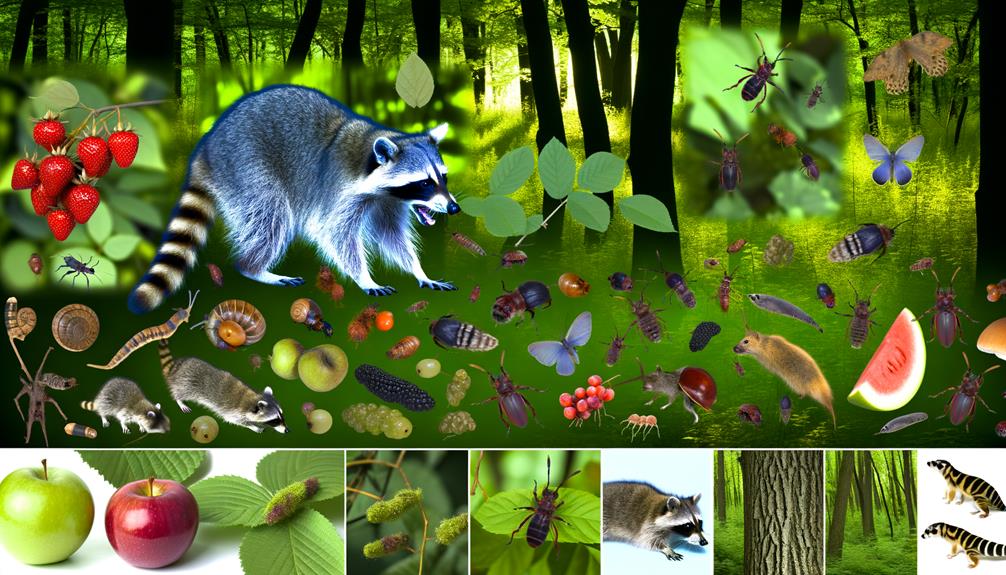
Raccoons' general diet is omnivorous and highly adaptable, encompassing a wide range of food sources including fruits, vegetables, insects, small mammals, and aquatic organisms. This dietary flexibility allows them to thrive in diverse environments, from urban areas to forests.
Raccoons exhibit opportunistic feeding behavior, adjusting their diet according to seasonal availability and local resources. During warmer months, they often consume a higher proportion of fruits and insects, while colder periods see an increased intake of nuts and small animals. Additionally, raccoons are known to forage in water sources for crayfish, frogs, and other aquatic life.
This varied diet not only supports their nutritional needs but also underscores their resilience and adaptability as a species.
Why Raccoons Hunt
The inherent need for sustenance and survival drives raccoons to hunt, leveraging their opportunistic feeding behavior and adaptable foraging strategies. These nocturnal mammals exhibit a diverse diet and exhibit hunting behaviors that are influenced by various ecological and biological factors. Raccoons' ability to thrive in different environments stems from their versatile predation tactics and resourcefulness. The following table highlights key reasons and methods raccoons employ in their hunting practices:
| Factors | Description |
|---|---|
| Opportunistic Nature | Rely on available food sources, adapting to the season. |
| Foraging Skills | Utilize keen senses to locate and capture prey. |
| Dietary Diversity | Consume a wide range of animal and plant matter. |
| Survival Instincts | Hunt to fulfill nutritional requirements and sustain life. |
Such multifaceted hunting behaviors underscore raccoons' ecological adaptability and survival instinct.
Moles as Prey
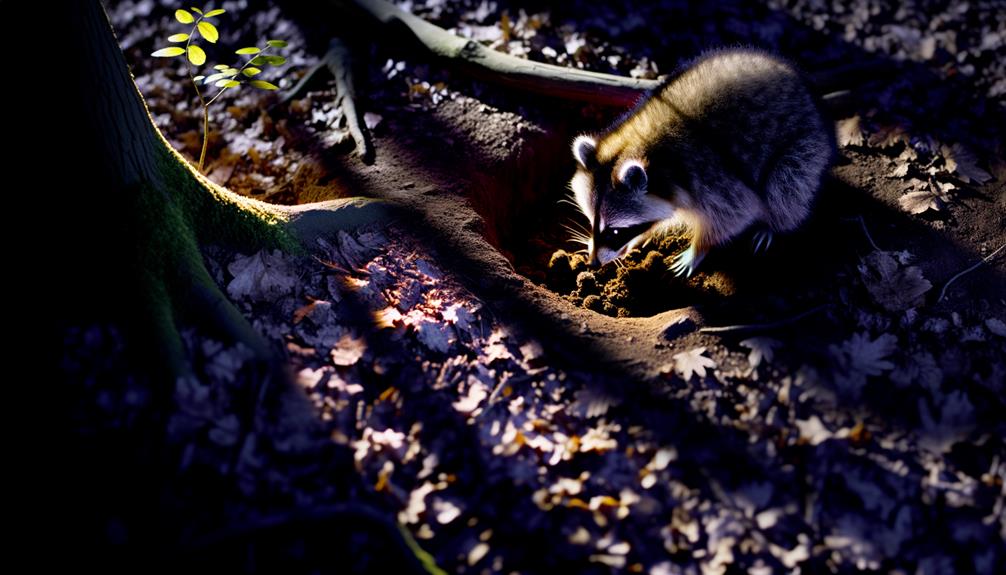
Moles, as subterranean creatures, present a viable prey option due to their abundance and nutritional value. These insectivores primarily inhabit moist, loose soil, which facilitates their tunneling behavior and makes them accessible to predators such as raccoons.
Moles' diets consist mainly of earthworms, insects, and larvae, thereby accumulating significant protein content, which is beneficial for raccoons. Moreover, raccoons exhibit a remarkable ability to dig and unearth moles from their burrows, leveraging their dexterous forepaws.
The presence of moles in various habitats, including gardens and agricultural lands, increases their likelihood of falling prey to raccoons. Consequently, the interaction between raccoons and moles can influence local ecological dynamics, impacting soil health and pest populations.
Voles as Prey
Given their small size and high reproductive rate, voles serve as a readily available and nutritious food source for raccoons in various ecosystems. Voles, belonging to the family Cricetidae, are small rodents that inhabit grassy areas, woodlands, and fields. Their diet primarily consists of vegetation, seeds, and insects, making them integral to the food web.
Raccoons (Procyon lotor), being omnivorous and opportunistic feeders, often exploit the abundance of voles for sustenance. This predation is ecologically significant, as it helps regulate vole populations, preventing overgrazing and potential habitat degradation. Moreover, voles' high reproductive capacity guarantees a constant supply, aligning with the raccoon's adaptive foraging strategy.
This dynamic underscores the intricate balance between predator and prey within their shared habitats.
Hunting Methods
While raccoons exhibit a diverse range of hunting methods, their techniques for capturing voles and moles are particularly adapted to exploiting the subterranean habits of these small mammals.
Utilizing their keen sense of smell, raccoons are adept at locating the tunnels and burrows of voles and moles. They employ their dexterous forepaws to dig and unearth these creatures from their underground refuges. Additionally, raccoons display patience and strategic thinking, often waiting near active burrow entrances for these small mammals to emerge.
Their nocturnal nature further aids in these pursuits, as they can hunt under the cover of darkness when voles and moles are most active. This combination of sensory acuity and behavioral adaptability makes raccoons effective hunters of these elusive prey.
Seasonal Variations
Seasonal variations considerably influence the dietary habits of raccoons, impacting their consumption of moles and voles.
During winter, raccoons may turn to alternative food sources due to the scarcity of these small mammals.
Conversely, in spring and summer, changes in hunting behavior and dietary preferences reflect the increased availability of moles and voles, aligning with their reproductive cycles and population dynamics.
Winter Food Sources
In winter, raccoons adapt their diet to the availability of food sources, which often includes moles and voles. As temperatures drop and vegetation becomes scarce, these small mammals become more significant in the raccoon's diet due to their accessibility and nutritional value.
Raccoons, being opportunistic feeders, exploit the subterranean habitats of moles and voles, which are less active above ground during colder months. This dietary shift is essential for maintaining energy reserves when other food sources are limited.
Additionally, raccoons may also rely on other winter food sources, such as carrion, insects, and any remaining fruits or nuts. Understanding these dietary adaptations provides insight into the ecological flexibility and survival strategies of raccoons during winter.
Spring Hunting Behavior
As spring arrives, raccoons exhibit distinct hunting behaviors that reflect the increased availability of diverse prey and food sources. During this season, their foraging activities become more pronounced, targeting a variety of small mammals, insects, and amphibians. The emergent flora and fauna provide raccoons with ample opportunities to diversify their diet. Their nocturnal excursions are characterized by heightened activity in areas rich with vegetation and water sources.
| Prey Type | Frequency of Predation |
|---|---|
| Moles | Moderate |
| Voles | High |
| Frogs | Moderate |
| Insects | Very High |
| Bird Eggs | Moderate |
This table illustrates the frequency of predation on various prey types during spring, showcasing the dietary adaptability of raccoons in response to seasonal changes.
Summer Dietary Preferences
Raccoons' dietary preferences shift noticeably during the summer months, reflecting the seasonal abundance of fruits, berries, and other plant-based foods. This period sees a marked increase in the consumption of available soft mast such as blackberries, cherries, and apples.
The heightened availability of these high-energy food sources influences raccoons to diversify their diet, reducing their reliance on animal prey, including moles and voles. Additionally, raccoons are opportunistic feeders and will consume a variety of insects, amphibians, and small mammals if the opportunity arises.
However, the predominance of plant-based foods in summer underscores their adaptability to changing seasonal resources. This dietary flexibility enhances their survival prospects and minimizes interspecies competition for food.
Impact on Ecosystems
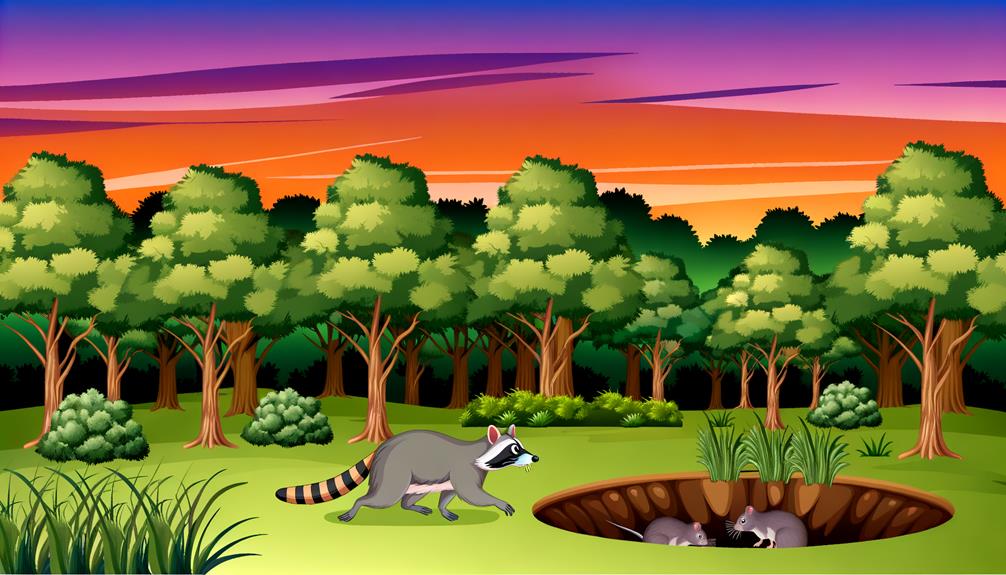
The predation habits of raccoons, particularly their consumption of moles and voles, play a significant role in shaping the population dynamics and health of local ecosystems.
By controlling the populations of these small mammals, raccoons help maintain a balance that prevents overgrazing of vegetation and soil degradation caused by the extensive burrowing activities of moles and voles. This ecological regulation promotes the growth of diverse plant species, thereby supporting a variety of other wildlife.
Additionally, raccoons' predation on these rodents can mitigate the spread of diseases and parasites associated with high-density vole and mole populations. Such trophic interactions underscore the importance of raccoons in fostering ecosystem resilience and biodiversity.
Signs of Raccoon Activity
Indicators of raccoon presence in an area can often be identified through a combination of physical evidence and behavioral patterns. These nocturnal animals leave distinct signs that can be observed by those familiar with their habits. Common indicators include tracks, scat, and damage to property or vegetation.
| Indicator | Description |
|---|---|
| Tracks | Five-toed footprints with long fingers, often found near water sources. |
| Scat | Typically dark, tubular, and found in prominent locations. |
| Gnawed Structures | Evidence of chewing on wood, siding, or wires. |
| Overturned Garbage | Raccoons are known for rummaging through trash cans and creating a mess. |
| Nesting Sites | Found in attics, chimneys, and hollow trees, often containing leaves and debris. |
Identifying these signs helps in understanding raccoon activity and evaluating their impact on the local environment.
Preventing Raccoon Visits
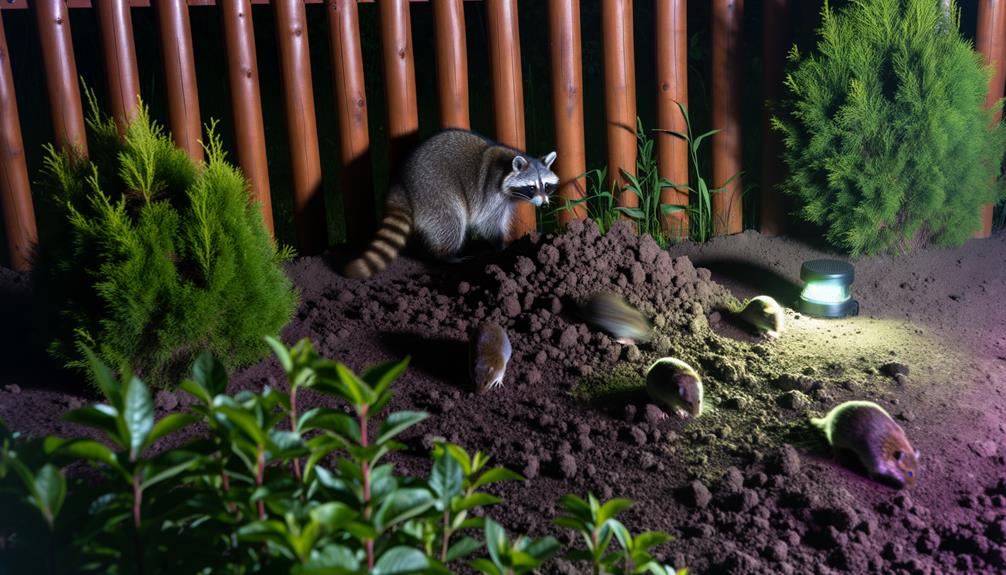
To effectively prevent raccoon visits, it is essential to implement several strategic measures.
Securing trash bins, removing accessible food sources, and installing motion-activated lights are vital steps in deterring these nocturnal animals.
Each of these actions contributes to creating an environment that is less attractive and accessible to raccoons.
Secure Trash Bins
Securing trash bins is an important measure in deterring raccoons from scavenging in residential areas. Raccoons are highly adaptable and opportunistic foragers, frequently attracted to the easily accessible food waste found in unsecured trash bins.
To mitigate this attraction, residents should employ sturdy, raccoon-proof trash bins with tight-fitting lids. Bungee cords or specialized locking mechanisms can further enhance the security of these containers. Additionally, placing trash bins in an enclosed area, such as a garage or a specially designed bin enclosure, can significantly reduce raccoon access.
Regular maintenance, including promptly cleaning spills and ensuring bins are not overfilled, also plays a crucial role in minimizing attractants. Implementing these strategies effectively curbs raccoon visitation and promotes a harmonious residential environment.
Remove Food Sources
Eliminating accessible food sources is a fundamental strategy in preventing raccoon visits to residential properties. Raccoons are opportunistic feeders, drawn to easily accessible sustenance. By removing food sources, homeowners can notably reduce raccoon activity. Measures such as cleaning up fallen fruit, securing pet food indoors, and maintaining bird feeders can deter these nocturnal creatures. Below is a concise table illustrating effective practices to eliminate food sources:
| Food Source | Preventative Measure | Benefit |
|---|---|---|
| Fallen Fruit | Regularly rake and dispose | Reduces attraction to yard |
| Pet Food | Feed pets indoors | Limits raccoon access |
| Bird Feeders | Use raccoon-proof feeders | Minimizes spillage and interest |
| Compost Piles | Use enclosed bins | Prevents rummaging and feeding |
| Outdoor Grills | Clean after each use | Removes food residue and odor |
Install Motion Lights
Implementing motion-triggered lights can deter raccoons from frequenting residential areas. These nocturnal creatures are primarily active during the night, seeking food and shelter.
Motion-triggered lights disrupt their activities by startling them with sudden illumination, thereby encouraging them to avoid well-lit zones. The effectiveness of these lights hinges on their strategic placement near potential entry points such as garbage bins, gardens, and entryways.
Additionally, utilizing lights with an adjustable range and sensitivity ensures they activate upon detecting the presence of raccoons. This non-lethal deterrent method aligns with humane wildlife control practices.
Moreover, integrating motion-triggered lights with other preventative measures, like securing trash and removing attractants, can greatly reduce raccoon visits and mitigate potential property damage.
Natural Predators of Raccoons
Although raccoons are adaptable and resourceful animals, they do have several natural predators that pose significant threats to their survival. Chief among these are larger carnivores such as coyotes, bobcats, and mountain lions, which are known to hunt raccoons.
Additionally, birds of prey, notably great horned owls and eagles, may target young or small raccoons. Humans also represent a considerable threat, both through direct hunting and indirect means such as habitat destruction and vehicle collisions.
Moreover, domestic dogs can sometimes act as predators, particularly in suburban and rural areas. Understanding these natural threats is vital for wildlife management and conservation efforts aimed at sustaining raccoon populations while balancing ecosystem dynamics.
Conclusion
To conclude, raccoons, as omnivorous opportunists, integrate moles and voles into their diverse diet, acting as ecological balancers within their habitats. Their hunting techniques and dietary preferences illuminate their role as intricate threads in the tapestry of ecosystem dynamics.
Recognizing signs of raccoon activity and employing preventive measures can mitigate their impact. Understanding the natural predators of raccoons further enriches the comprehension of the intricate web of predator-prey relationships in nature.




